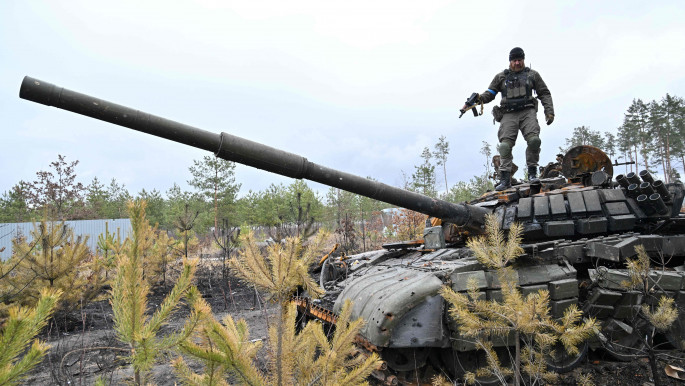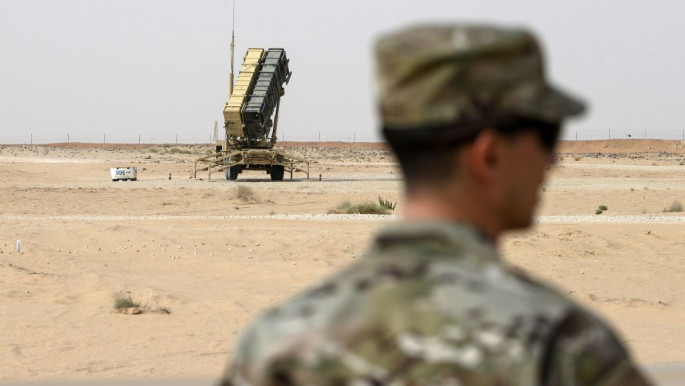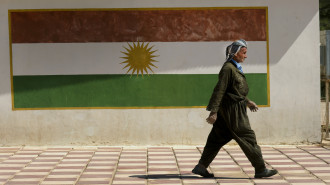
How the Ukraine war is impacting Russia's arms sales to the Middle East

Although the global arms trade has been relatively steady in recent years, at least until the beginning of the Ukraine war, demand from the Middle East has continued to grow, reaching almost 33% of the global market.
The US is the leading supplier, with as much as 47% of its entire arms exports between 2016-2020 going to the Middle East - an increase of 28 percent from the previous five years. Saudi Arabia has been the top buyer, with 11 percent of global imports.
Will Russia's exports significantly fall?
Many analysts predict that Russia’s traditional clients may face supply shortages due to Moscow’s invasion of Ukraine, with Russia quickly depleting its own military arsenal and domestic manufacturers under serious pressure to meet the demands of their own army.
Besides logistical difficulties and supply shortages, Russia’s buyers will also find it extremely difficult to conduct any kind of business transactions, especially with the Russian defence sector.
"Although the global arms trade has been relatively steady in recent years, demand from the Middle East has continued to grow, reaching almost 33% of the global market"
Moreover, the introduction of heavy controls aimed to block Russia from acquiring semiconductors, aircraft components, and other advanced technologies crucial for Russia’s defence industry may hamper its production efforts and consequently affect the potential for further exports.
The conflict in Ukraine has also raised questions about the quality of Russian military equipment, especially regarding tanks and armoured personnel carriers.
“The war in Ukraine is damaging the reputation of Russian weapons,” Bruce Riedel, senior fellow and director of the Brookings Intelligence Project, told The New Arab.
In a similar vein, Frank Slijper, an arms trade expert from PAX, a peace organisation based in the Netherlands, observes that “whereas many thought that Russia was on its way to becoming a stronger rival of the US industry, the past half-year has clearly proven that this was wrong”.
The war in Ukraine will “clearly affect its ability to materialise existing arms deals, and together with the pre-existing threat of US sanctions against any country buying Russian weapons (CAATSA: Countering America's Adversaries Through Sanctions Act), Russia's arms industry is clearly suffering badly, and it remains to be seen how many years it may take them to recover,” he told The New Arab.
Although there are many reasons to expect that Russian arms exports will decline, Pieter D. Wezeman, a senior researcher at SIPRI, recalls that the actual public evidence for that expectation is still scarce.
For example, “it has still not been confirmed if Russia will be exporting new SU-35 combat aircraft to Egypt, if these instead will be sold to Iran and if and when they can actually be delivered,” Wezeman told The New Arab.
However, Elias Yousif, a research analyst with the Stimson Centre’s Conventional Defence Program, says Russia’s war in Ukraine has done more to expose deficiencies in Russia’s military planning and campaign design than its equipment.
While there has been some reporting on practical problems with Russian armour, Moscow’s failures in Ukraine, “will not inspire unconfidence in its utility as a military partner,” he says.
Speaking to The New Arab, Alexey Khlebnikov, a MENA expert at the Russian International Affairs Council, recalls that Russia's main arms export in 2017–21 were aircraft, which accounted for 48% of its total arms exports, followed by engines, mainly for aircraft (16%), and missiles (12%), while tanks and armoured personnel vehicles have not been its major export product.
“This is why it is unlikely that interest in Russian jets, missiles, and air defence systems will significantly fall,” he noted.
|
|
As for Vasily Kashin, Director of the Centre for Comprehensive European and International Studies at the HSE University in Moscow, it is important to note that “Russia is continuing to export arms at a considerable scale. During the first half of the year Russian weapons deliveries were $6bn”.
According to him, there is no issue with Russia’s ability to deliver its arms to customers. There is, however, an issue of the US pressuring Middle Eastern countries to stop their purchases. However, “there are countries which are immune to such pressure, such as Iran, and I expect a huge surge of the sales of Russian weapons and defence technology to this country,” he told The New Arab.
The ability to export to the rest of the region will depend on the scale of US political influence there, Kashin added, and that influence seems to be in decline, with recent OPEC+ cuts being one example.
"The war in Ukraine is damaging the reputation of Russian weapons"
Will other suppliers replace Moscow?
The potential decrease in Russian arms sales could create new openings for other suppliers. However, Yousif notes that it’s important to remember that Russia’s share of the Middle East arms market remains relatively small – so even if declines in Russian arms transfers created an opening for other arms exporters, it would be relatively marginal.
While China has often been mentioned as a candidate to replace Russia, Khlebnikov observes that Beijing only accounts for 4.6% of total global arms exports and its major buyers are in Asia and Oceania, where 79% of Chinese arms exports went.
Moreover, Chinese arms exports decreased by 31% between 2012–16 and 2017–21. “It is very unlikely that China might rapidly increase its arms exports to the region,” Khlebnikov told The New Arab. In fact, Wezeman explained that in Egypt, China has lost terrain in the arms market to France, Germany, Italy, and recently South Korea, and the US remains committed to its long-standing and substantial military aid to Egypt.
“Russian arms sales to Iraq have not been very impressive in the first place, and over the past few years there have been reports of Iraq turning to France when discussing possible contracts for major military equipment.”
Turkey, meanwhile, is increasingly catering for its own arms industry, mainly based on technology from Europe and the US. But since the Middle East and Asia-Oceania are the most competitive markets in the world, Khlebnikov notes that it would be hard for any arms supplier to significantly increase its market share in those regions.
Nevertheless, China and other exporters will continue to seek to expand their arms sales in MENA and gain advantages wherever Russian weaknesses as an arms supplier show. Therefore, Kashin expects that some countries may switch from Russian to Chinese weapons in the medium term, just to avoid tensions with the US.
“The problem is that Sino-US relations are also declining fast and soon Chinese arms sales in the Middle East would be just as problematic for the West as the Russian sales, especially once a Chinese attack on Taiwan takes place,” he added.
|
|
The US versus other suppliers
Some analysts suggest that because of new geopolitical conditions the US may be tempted to view regional arms sales as yet another extension of US competition with China. In Yousif’s view, the United States has long seen arms transfers as an important instrument for fostering international influence, especially in the Middle East.
In that context, Washington will certainly see any potential efforts by China to be more militarily engaged in the region as an extension of its strategic competition with Beijing.
However, Slijper explains that in most cases China and the US cater to different markets and China usually deals with militaries around the world, such as in Africa, that have budgets that cannot afford much more expensive US military equipment.
Some experts suggest that the Biden administration should be cautious when making any new deals and insist that the US consider the human rights violations or the instability that such arms sales might trigger.
"As much as 47% of US arms exports between 2016-2020 went to the Middle East"
Although Biden has pledged to break away from the policies of his predecessor Donald Trump, the CATO report states that “to date, the Biden administration has continued Trump administration policies that increase the risks from arms sales in general".
Slijper strongly doubts whether human rights concerns would be a criterion for US companies to be allowed to compete for Russia's market share, except for China of course, where geopolitical concerns weigh heavier than human rights concerns.
Most of the other major Russian customers (such as India, Egypt, Algeria, and Vietnam) could in principle turn to US alternatives if they can afford them. “In fact, a high-ranking US official recently mentioned this as a positive side-effect of the war in Ukraine,” Slijper noted.
But according to Riedel, the US Congress is “not likely to authorise any new arms deals with the Kingdom and possibly other Gulf states.” He also thinks that Washington’s relationship with its biggest arms purchaser, Saudi Arabia, is in jeopardy due to Riyadh’s flirtation with Moscow and its decision to reduce oil exports.
Consequently, the Biden administration, the American public, and Congress, “are all growing increasingly frustrated,” according to Yousif, “as the multi-billion dollar security cooperation relationship with the region isn’t translating into meaningful foreign policy outcomes”.
And in light of the OPEC+ decision to cut oil production rather than boost sales, analysts say Washington is taking an increasingly sceptical view of its arms transfers to the region, with the connection between supplies and political influence increasingly unpredictable.
Stasa Salacanin is a freelance journalist who has written extensively on Middle Eastern affairs, trade and political relations, Syria and Yemen, and terrorism and defence.





 Follow the Middle East's top stories in English at The New Arab on Google News
Follow the Middle East's top stories in English at The New Arab on Google News


